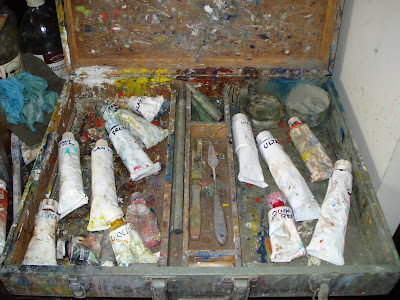
I was in the Boston Globe today. I taught a three day seascape workshop entitled "Seascape painting for the non-amphibian" for the Rockport Art Association, today was the last day. I had thirteen students. The first day I taught in the studio, demonstrating how to paint an "ideal" wave. No photos allowed. We did watch some movies on my computer of waves though. I can stop them and point out the anatomy of the surf. But we used no photo references during the painting.Then in the afternoon I had the students paint their own waves and I went from easel to easel helping them. Afterward we went out to Lobsta-Land for dinner and I drew on napkins and taught while we waited for our dinner.
Saturday we went to Plum Cove in Gloucester, it was a perfect day on the beach. The sun was warm and the light was good. We painted the cove with its rocks and distant views across Ipswich bay. It was about as perfect as an early autumn day in New England gets. While we were there a photographer showed up and took a series of pictures of us working and introduced himself as a photographer for the Globe, so I tried to lean a little to the left in order to be more appealing to their readers.
That must have worked as today my old friend Don Mosher showed up at my workshop with a photo clipped from the newspaper of me painting on the beach. I am wearing my Grateful Dead T-shirt and paint splattered jeans, surrounded by ladies in floppy hats.
On the third day of the workshop, today, we returned to the studio and used our paintings from Plum Cove as a reference to make a new painting with surf in it. I again did a demo in the morning of that, and in the afternoon the class did their own surf paintings. I have added a day of seascape instruction to a landscape workshop before, but this is the first exclusively seascape workshop I have ever done. I had a lot of fun, although I returned home exhausted every night at about 10:00. I think the students enjoyed it and I think they learned a few things. I really enjoyed meeting them and tried as hard as I could to make myself useful.
=======================================================
Below is a materials list for upcoming workshops. Those of you in the Maine workshop will receive an e-mail shortly providing information specific to that.
 Here are the materials you will need for my workshop.
Here are the materials you will need for my workshop.You will need a a french easel, a pochade ( pronounced "pochade") box and tripod, or a Gloucester easel. Aluminum collapsing easels and little wooden tripod easels are generally not steady enough and they won't hold your palette. I don't recommend them.
PAINTING IS HARD ENOUGH WITH THE BEST OF MATERIALS!
In your paintbox you will need:
Titanium White
cadmium yellow medium or light
cadmium red light
burnt sienna
either cobalt, Prussian, or pthalocyanine blue
yellow ochre
ultramarine blue
Permanent alizirin or quinacridone red
viridian or permanent green deep
you also might want, but won't require,
Ivory black or
cobalt violet
a palette of some sort, most easel setups include a palette.
a medium. I like Liquin or Galkyd but if you like an oil and varnish medium that is fine too. You may already be using a medium at home, bring that. Also you will need a top from an olive jar or a small oil cup to put it in.
mineral spirits or turpentine, and a tuna fish can to put that in.
A roll of Bounty or Viva paper towels, all others are inferior. Also a grocery store plastic bag for them after use.
A selection of flat brushes, a couple of #1's, several #4's, a #8 or 10 and a short handled rigger, synthetic or sable, about a #4 . Also a leaf shaped palette knife.
You will need a hat with a substantial brim, a baseball hat works well. I carry a container of Goop, you can get that at Wall Mart or an auto supply store, to use cleaning your hands.
A fine cigar or two, possibly a maduro, box pressed if possible, no White Owls or plastic mouthpieces please.
Several canvases, or panels to paint on. Please no cardboard artist boards they are floppy and impermanent dreadful things. Gessoboard is nice, sourcetek panels are good, clayboard is too absorbent. I think a 16 x 20 is the ideal size. Small canvases bring an added complexity to painting as you need to miniaturize nature to go on them. Don't bring anything larger than an 18 x 24 unless you are a pro.
Some people like to have an umbrella to shade their canvas, I don't use one, but you might.
A camera, you will want to get a shot of what you are painting because it may save the project later in the studio.



0 Yorumlar